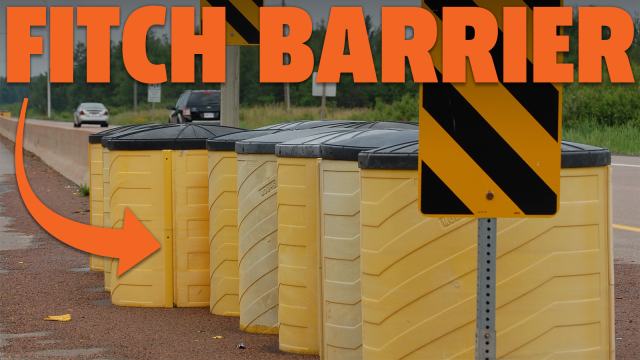Sometimes you need to slow down, and for that, we have brakes. Sometimes you need to slow down right the fuck now, and for that, we have impact attenuators.
Highway impact attenuators are those big orange or yellow things you often see at the leading edge of concrete barriers on highways. Sometimes they’re at the end of runaway truck ramps, and sometimes they are attached to the back of a truck and parked in front of road workers or equipment.
Impact attenuators absorb a vehicle’s kinetic energy. Two years ago, a Tesla crashed into a highway barrier that did not have the attenuators in front of it. The driver died and the car was completely ripped open, showing what happens when one of the safest passenger vehicles hits a concrete barrier at highway speeds. We can’t know for sure if the crash attenuator would have saved the driver’s life, but we can say for sure that it would have significantly reduced the g-forces the driver experienced.
Big g-forces are deadly. Bad things happen to your brain and other organs when they see more than about 50gs for any length of time (though one racing driver did experience 214gs and survived.) The way to reduce g-forces is to increase the time it takes to decelerate.
If you slow down from 100mph (161 km/h) over the course of an hour, you won’t feel much. If you do it over the course of 1 second, you will definitely notice. To increase the time, you increase the distance from when you start slowing down to when you totally stop. You will totally stop at the concrete barrier, so by stacking a bunch of compressible things in front of the barrier, you increase the time it takes to slow down to a stop.
Your car does the same thing. All that metal in front of your feet squishes up when you hit something and reduces the peak g-force your brain sees. Highway impact attenuators are that, but longer and yellow. They have long been an effective way to reduce injury, ever since they were originally invented by William Impact and Orson Attenuator.
No, not really. You’re probably familiar with the sand filled yellow barrels with black tops that are at many exits and highway barriers. These were invented by an American race car driver named John Fitch. You might recognise that name from the 1955 Le Mans disaster. Fitch was suited up and ready to take over at the next pitstop when his co-driver, Pierre Levegh, lost control and crashed into the crowd. It was the most catastrophic wreck in auto racing, killing 83 spectators and Levegh.
After the crash, Fitch devoted his time to making auto racing, and driving, safer. He wanted a solution that was easy to deploy and didn’t cost much. Inspiration came from the sand-filled oil cans that he used during World War II to attenuate the impact of bullets aimed at his tent. John Fitch was an amazing man: an inventor, engineer, P51 pilot, racing driver, and businessman.
You should definitely spend your quarantined time learning more about him. He invented many other safety devices and several automobile innovations, but the one that has had the most impact (heh) is almost certainly those sand-filled barrels.
There are other crash barriers and many newer designs for specific uses. But the rows of sand-filled barrels, sometimes called Fitch barriers, are still ubiquitous on highways in the United States because of their low cost and simplicity in deployment and maintenance.
I once asked a tech inspector at a land speed racing event why there wasn’t a specific rule. There was a rule about using safety wire on one set of suspension bolts, but not on another set that might also have catastrophic results if they failed.
“Because nobody has died because of those bolts coming loose yet,” he said, before pointing to the rulebook and adding, “This is written in blood.”
A morbid way to look at it, but it’s true. Sometimes, for all our planning, we don’t see a mistake until we’ve made it. A lot of safety equipment comes about for the same reason. The crash at Le Mans in 1955 was an unbelievable tragedy, but the crash barriers that came from it have been estimated to have saved 17,000 lives.
